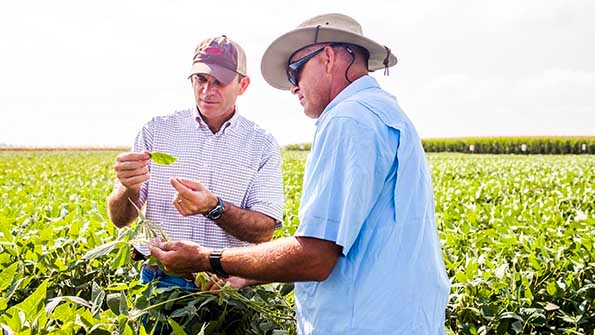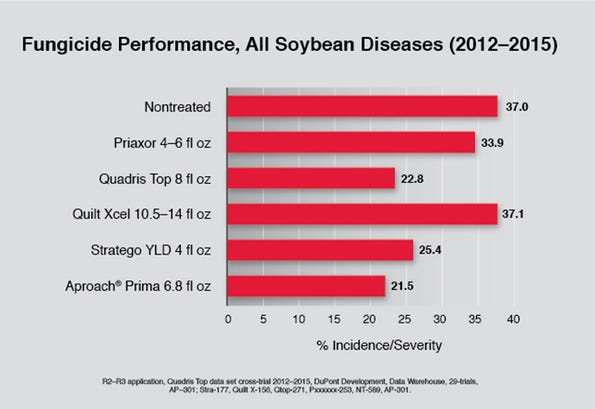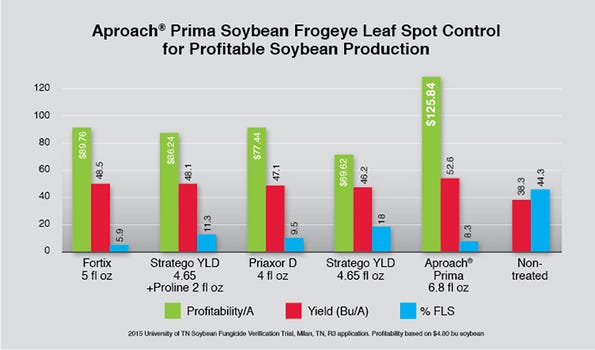
Can Your Fungicide Pass This Test?
After choosing the right soybean variety for every field, the next action item should be choosing a crop protection program to match, including a top-performing fungicide. In the warm and humid South, an effective fungicide program usually pays dividends beyond the cost of the fungicide.
May 23, 2016

Sponsored Content
The best way to battle low commodity prices is to increase yield. After choosing the right soybean variety for every field, the next action item should be choosing a crop protection program to match, including a top-performing fungicide. In the warm and humid South, an effective fungicide program usually pays dividends beyond the cost of the fungicide.
“If you have a favorable environment to grow soybeans in the South, you’re also going to have ideal conditions for disease,” says Bond McInnes, fungicide technical manager with DuPont Crop Protection. “Soybean plants grow well in moisture, heat and humidity and so do fungal diseases that thrive on and under dense leaf canopies. Fungal pathogens, including frogeye leaf spot, leaf blights, rusts and brown spot, threaten plant health and yield.”
Application Timing Matters
McInnes says high inoculum loads and cool, wet conditions favor early disease infections on soybeans this season. “The earlier an infection occurs and the longer it goes untreated, the greater the potential impact on yield.”
Application timing for soybean fungicides is typically most profitable at the R2 to R3 growth stage, he adds. “Evaluate disease pressure and potential for disease before soybeans reach the R2 stage. Getting the disease controlled early prevents leaf disruption and yield loss due to poor photosynthesis.”
Choose the Right Fungicide
Fungicides are not the same. Even when you choose a fungicide with multiple active ingredients, be aware of performance differences between the available active ingredients, says McInnes. He advises looking for these product characteristics to maximize return on fungicide investment:
Broad-spectrum control of key fungal diseases
Curative, preventive, eradicant and antisporulant activity
Proven action against fungicide-resistant strains of frogeye leaf spot
Movement within the plant to protect existing leaves, stems, emerging leaves and pods
Residual protection that lasts 21 days
Enhanced foliar health and photosynthesis under a range of conditions
Excellent crop safety that won’t set back soybean plant growth or reduce photosynthesis
One product that combines those best qualities is DuPont™ Aproach® Prima fungicide, which delivers excellent distribution within the plant, and long-lasting residual, preventive and curative control. Its two modes of action help manage disease resistance and combine to protect over the life of the plant.

Four years of data collected at research plots against all soybean diseases across the U.S. shows fungicide performance in reducing disease severity when used at full labeled rates.
Four years of data collected at research plots against all soybean diseases across the U.S. shows fungicide performance in reducing disease severity when used at full labeled rates.

Using a price of $8.80 per bushel for soybeans, 2015 University of Tennessee frogeye leaf spot trials showed Aproach® Prima provided top profitability per acre compared to other fungicide applications and untreated check plots.
Using a price of $8.80 per bushel for soybeans, 2015 University of Tennessee frogeye leaf spot trials showed Aproach® Prima provided top profitability per acre compared to other fungicide applications and untreated check plots.“If conditions favor disease or crop stress, apply a full 6.8-fluid-ounce rate of Aproach® Prima,” says McInnes. “Data collected over four years across all diseases, conditions and regions of the U.S. has shown excellent reduction in disease severity, while data collected to evaluate performance under high frogeye leaf spot pressure at the University of Tennessee in 2015 showed superior disease control and return on investment.”
Foliar Health Benefits
Growers have observed that Aproach® Prima application helps keep leaves green for maximum photosynthesis. McInnes says plant greening effects contribute to improved foliar health, greater biomass and higher yield potential.
“As we continue to conduct our research at DuPont, it’s evident that the active ingredients in Aproach® Prima make plants more stress-tolerant so they can produce more yield with improved grain test weight. We’ve seen this even in dry years when disease pressure was low.”
Research at Mississippi State University shows the various strobilurin fungicides have similar dose-dependent effects on plant physiology, but differ in potency. One of the active ingredients in Aproach® Prima, picoxystrobin, has been shown to be highly effective in reducing the rate of conductance of water through stomata of soybean leaves. This often results in an improved water use efficiency (WUE) ratio of net photosynthesis to transpiration.
For more information, visit foliarhealth.dupont.com.
Always read and follow all label directions and precautions for use.
Unless indicated, trademarks with ®, ™ or SM are trademarks of DuPont or affiliates.
You May Also Like



